
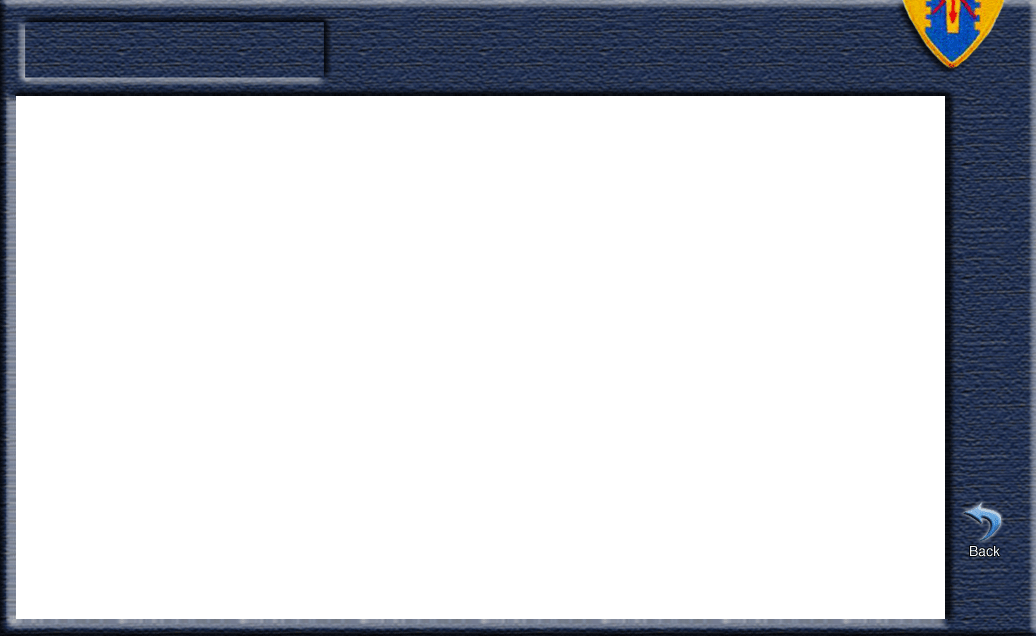
Year of the Rat
Pat's recollection of several incidents during Tet '68 combat operations (see also The Battle for Saigon & The Vinatexco Cotton Mill)
As 1967 closed out and 1968 arrived, there was a noticeable pickup in hostilities. Even though we had been busy, it appeared that every time we went up, we were engaging the enemy. They seemed to be better armed, and there seemed to be more of them. The incident described earlier where Smokey got shot down and the 35 element got shot up occurred just two days prior to what is now known as Tet of 68. As soldiers in the front, we had no knowledge of any buildup other than what our intuition told us. I do not remember getting any intelligence from our briefings that there was a major buildup of enemy troops, but it was somewhat obvious that the war was accelerating. Cu Chi and Dau Tieng were getting mortared pretty regularly, keeping us tired and irritable. Sleep was never easy except with the help of alcohol, but now even the slightest noise kept us awake. "Incoming" was a cry/curse that was even heard during the day, which was out of character for the VC, who mainly mortared us at night.
31 Jan was the Vietnamese New Year, bringing in the year of the Rat. Having lived in Okinawa as a kid, I was somewhat aware of the Oriental New Year, and how each year was named the year of the Pig, Goat, Rat, etc., but it had no real meaning for an Occidental such as myself. I knew that the ARVNs were probably getting drunk in their celebration of the New Year, just as we did on the night of the 31st of December, and that was about the extent of my understanding. The North Vietnamese, much wiser, knew that this would be a perfect time to start a major assault on the South, while the ARVNs were down on their guard. Of course, we believed that the ARVNs had much to learn about how to fight, anyway. My experience with them was never good. They were very happy to let the Americans do the dirty work, and didn't seem to care much about whatever might happen to their country. At any rate, the NVA knew that the alert level of the ARVN would be even lower, making their job that much easier. Their buildup had been going on right under our noses for some time, and while we knew that there was more action, we had no real idea of what was going on.
I write this from the perspective of an individual of little rank, who basically was out of the loop as far as long range goals. The generals no doubt had much more that they knew, and the history books have proven that. But for the Warrant Officer pilot, our world was from mission to mission, not really understanding or even caring about an overview. We were trying to not get shot down, not get killed or maimed in the mortar attacks, and make it through another mission while counting the days to DEROS (Date Eligible for Return from Overseas). This is pretty much the plight of the common soldier in all wars; while the big guys with the stars on their epaulets direct our lives and think about the big picture, the people in the shit just try to make do, to survive to live and fight another firefight, while thinking about where they would rather be.
On the night of 31 Jan, I was detailed to fly a LRRP extraction. The LRRPS (Long Range Reconnaissance Patrol) were along the Saigon River, north of Saigon, and they were reporting large enemy troop movements in their area. They rightfully were scared of being detected, and made their way to a spot where they could be picked up by one of our slicks. I flew gun cover, and I don't recall any problems with the extraction. Put yourself in the place of the slick crew, however. LRRP extractions were usually hot, you are landing in a spot where your only point of reference is a flashlight or strobe, you cannot use your landing light for fear of being shot, at any second you could be fired upon by unseen VC who are just waiting to be the proud soldier that got an American helicopter, and all the while the people that you are picking up are speaking in frightened tones because they are surrounded by enemy troops. All I had to do was give gun cover; the slick had to make the approach, get the LRRPS, and get out in one piece. NO FUN!
During the extraction, we saw ARVN compounds all around the area welcome in the Year of the Rat, pointing their weapons skyward and firing tracers into the air. Of course, with us being IN the air, we weren't too impressed with their lack of concern for our safety, but at the same time, the show was impressive. On our return to Cu Chi after the completion of the extraction mission, we took a wide berth around any ARVN compounds so as not to become a casualty of their drunken revelry.
About 0200, while we were trying to get some Zs, we were awoken by huge white flashes accompanied by tremendous explosions. My first experience with the NVA and their 122mm rockets was just what they hoped for; something that would scare the crap out of us, put us on edge, and generally disrupt our lives. As those first rockets started to fall, we in the Centaurs who were not assigned to fly made a mad dash to trenches which were in the process of becoming bunkers, but now were merely holes in the ground. We lay there, covering up as best we could, listening to a sound that in the next few weeks become all too familiar; the WHOOSH of the incoming rockets, followed by the deafening explosion and flash that made night into day for a millisecond. The enemy was evidently targeting the flight line and runway, and since we lived on the flight line, our area was nailed by the rocketeers. As the rockets came in, it became easy to judge when they were going to land close or pass us by, and as the close ones were about to hit, we hugged mother earth and hoped/prayed that it wouldn't be the last thing that we ever heard. The initial attack was over in a few minutes, and then, giving us a while to think that maybe it was over, another barrage ensued. By the second attack, I was in flak jacket and pisspot, but hearing the intensity of the explosions, there was little comfort in wearing such protection. As yet, I had not seen the crater that a 122 left. When I did, in our troop area and in the Corral after first light, it was obvious that if you were anywhere near the point of impact you could kiss your ass goodbye. All of a sudden, mortar attacks seemed almost fun in comparison to rockets.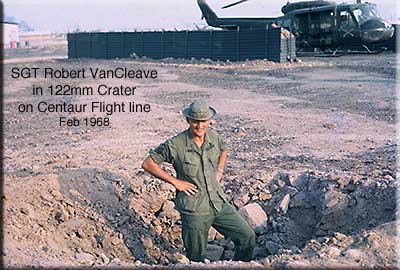
Dawn of 1 Feb broke, showing overcast skies, weather indicative of our moods after surviving our first rocket attack. The craters left by the 122s were about 10 to 12 feet across, and maybe 6 feet deep. One had hit near my aircraft that I had flown earlier that night on the LRRP mission, and the helicopter would not be flyable for some time, having numerous holes ripped in it from the rocket. We dug part of that rocket out of its crater, seeing ChiCom markings on it. As we were looking at it, the SCRAMBLE horn sounded from Operations. I didn't have an aircraft to fly, but went to Ops to see what was going on. Our Ops officer was giving the Number One standby team their mission; a large NVA force was attempting to overrun Tan Son Nhut Airbase, and they were to respond to give air support to the ground forces.
NVA!? Up to now, we knew that we had been fighting some NVA regulars, but most of our contacts were thought to be with VC. LRRPS had seen large movements of troops just Northwest of Saigon; that's why we got them out last night. Now Tan Son Nhut is being attacked. We always thought that TSN was out of the war; I had been to the Air Force Officer's club there once, and everybody looked like they were stateside. They seemed to regard us, in our worn fatigues, unshined boots, and "bush" odor as some kind of apparition. Now, they were getting attacked. At first, it almost sounded funny, and we could picture these guys in their starched fatigues or TWs (tropical worsteds) scrambling around, getting some of what we got, and not liking it.
Our Number One team cranked up, took off, and while still enroute to TSN called back and told Ops that there were NVA everywhere and that all available gunships needed to respond. All I could do was sit there, having had my ship damaged by the rockets. I sat in Ops, listening to the battle, and heard Doc (WO Jeff Halliday) saying that he was going in near the perimeter of TSN. Our squadron commander, LTC Glenn Otis, had gotten one of our slicks to use as his C and C bird, and they went in and got Doc and his crew. I will not get into specifics of what happened with the 3/4 Cav ground troops on this day, other to say that they literally saved Tan Son Nhut from the NVA, and Ltc Otis, with his leadership and bravery under fire, received the Distinguished Service Cross for his part in directing the ground units in their run from Cu Chi to Saigon. Without his actions, it is likely that the NVA would have taken TSN, at least initially. Other books have described what happened there, and did it much better than I can. My hoochmate, Mike Siegel, received a Distinguished Flying Cross for his actions of providing ammo resupply and medevac (That is another great story). Acts of bravery that day were numerous, and many were no doubt unheralded.
Meanwhile, I sat in base camp, a spectator in the first actions of Tet. That morning was long and, to understate, stressful. Those of us without aircraft to fly got sandbags and constructed makeshift bunkers. It seemed, after events of that night, that we might be needing them in the near future.
By that afternoon, I got assigned to relieve one of the other ACs, who had been on station most of the day and was more than ready for a break. I had heard that on every run there was intense return fire, but I had also heard that we were giving out heavy casualties to the bad guys, and while scared, I was ready to get in the action. As I lifted off and started heading towards Saigon, the smoke and fires from the battle were evident all along Highway 1. When I got on station, I was told that we were needed to fire on a warehouse just off of TSN, in the Cholon section of Saigon. Other fire teams were in the area, shooting up the world. It seemed really strange to be rolling in on buildings in the city of Saigon, but it was happening, none the less. At this point, such things as "no fire zones" were not applicable - everything was a fair target, because the NVA were seemingly everywhere. As I started my run on the warehouse, we received heavy AK fire from it, and we returned with rockets, minis, and door gun. As we expended our weapons into the building, it quickly became a smoking hulk, looking a lot like pictures that we had all seen of WWII bombed out buildings. Whoever had been in the building was no longer returning our fire after our passes. And from the look of the building, it was not a healthy place to be.
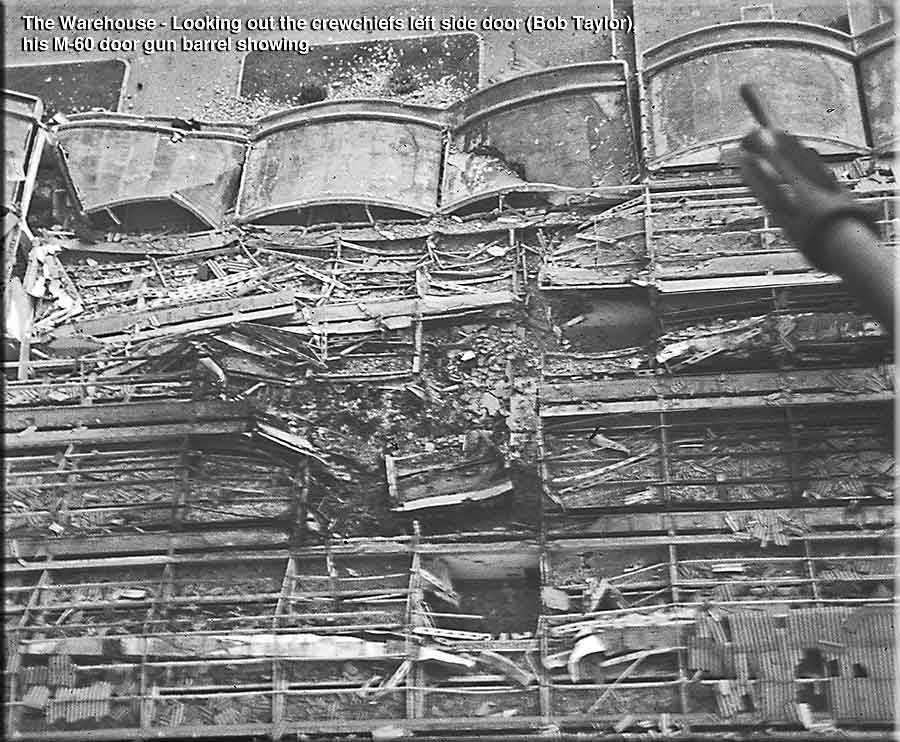
Photo Vinateco Cotton Mill
We returned with rearmed aircraft and continued our assault on the city of Saigon. We were directed to targets of opportunity by the ground troops, and worked in conjunction with the "Razorbacks", the gun platoon of the 120 AHC, whose home base was Hotel 3, the Tan Son Nhut helipad. They lived in villas, and in comparison to us had a pretty good life, but they were in the War now, and they gave a very good account of themselves. We also worked with some Air Force "Spookies", C47s equipped with several Minnie-guns that were operated by hand by their crews. As we received more and more fire, with a lot of 50 cal. mixed in, the Spookies climbed higher and higher, until their tracers were burning out above us, not doing a lot of good to the ground guys except moral support. In fact they put us at risk several times from being shot down by their fire.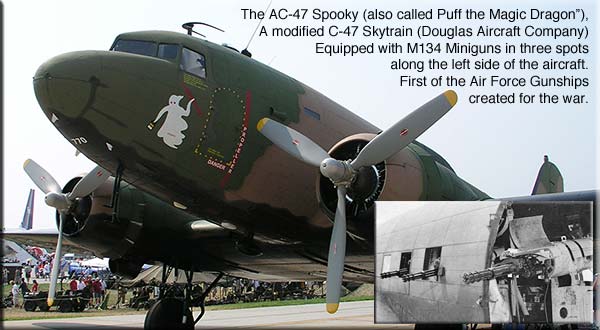
Try to picture this scene; there are the Spookies, circling the fight at maybe 5000 or 6000 feet. Below them are helicopter flareships, dropping flares to illuminate the area in their eerie glow. We are below the flareships, along with one or two other gunship fire teams. All the guns are flying blacked out, in order to make less of a target for the 50s. We in the guns are dodging flares, Spooky fire, the other fire teams, and the 50 cal and AK fire that showers us whenever we make a gun run. On the ground are many diverse units of US and ARVN troops, who are trying to stay out of our way and direct our fire on the best targets. The NVA are seemingly everywhere; whenever we make a pass on a target, Charles opens up on us from another position, not to mention those who we are shooting at returning fire at us in a most convincing manner. Fires are all around, from burning buildings, vehicles and the like. And while all of this is going on, our helmets fill our heads with radio chatter from the grunts, the Spookies, the other fire teams, our wingman, and our own crew, calling out such niceties as "we just received .50 fire from that building" or "the gooks just RPGd that APC down there!". All in all, the confusion of war was all around us. The whole thing seemed at times to be surreal, like you were in some sort of dream but couldn't awake from it. It wouldn't get a lot better for a long time.
Upon returning to Cu Chi, we found that we had been rocketed again. This, too, was to be an unpleasant fact of life for the next few months. Not chancing what seemed to be inevitable, we went to our makeshift bunkers to try to get some sleep. I had just dozed off when another rocket attack started. Laying in a ditch, wet, tired, scared and pissed off does not make for deep sleep. Guns on the perimeter opened up in force. The gooks must be attempting to breach our wire. I really don't need this shit, I say to whoever is close by, being the Master of the Obvious that I am. The guys on the wire are really shooting now, and the rockets are still falling. I hunker up, trying to become small, but knowing that a direct hit on my bunker and I am little more than a pink mist. I just hope that the odds will go my way for this attack. Although I know that I will never get used to this, in the months ahead I actually got to where I could sleep through a rocket
attack unless they were landing right in our troop area.
The next day brought little relief. I flew in support of more troops on the outskirts of Saigon, mostly Saber units that were cleaning up small patches of ground, retaking what had been ours a couple of days ago. Each fight was fierce, and while we didn't get shot down, we got many holes in our aircraft, requiring some immediate repairs for such things as the tail rotor driveshaft that was nearly severed by a 50, radios being shot out, and replacement of rotor blades when they got more than three holes in them (or, one .50, which would cause the aircraft to vibrate badly). On one of these numerous missions that all seem to run together, my chopper lit up a "Hydraulics" warning light. On a UH 1C, there are two hydraulics systems which allow for a backup system in case of a failure of the other. Charlie models cannot be flown with no hydraulics, unlike their other Huey brethren, because their larger rotor blades are just too powerful to be moved by humans. So, when we got the Master Caution light, our next procedure was to put the aircraft on the ground ASAP. We were only a short way from a Saber laager position, and as the bright young Warrants that we were, we decided to see if we could turn off the only functional system and see how the aircraft would handle. I had the aircraft, and my Peter Pilot turned off the switch for the number 2 hydraulic system (number one was the one that was inoperable). The helicopter immediately went into a violent right climbing turn, and I could not budge the cyclic, as much as I wanted to. As I was yelling to get the operable hydraulics turned back on, the Peter Pilot was reading my mind. As he flipped the switch back on, we both realized that if we should lose both hydraulics, we were screwed. We put the bird down at the Saber laager, hitched a ride back to Cu Chi in a passing slick, and left our aircraft to be towed back by a Chinook.
We learned more than we ever wanted to know about NVA .50 Cal. antiaircraft machineguns during this time. They were really .51s, being 12.7mm, but who was counting. The NVA were very good at setting up triangulated AA positions, and when we would roll in on one, two others would open up from other directions on us. When the bullets went by, there was a loud "POP", and I swear that the tracers looked as big as basketballs when directed at us. On one mission, I remember getting shot at by 4 different 50s from four different directions at the same time, with the tracers crossing each other and our ship as their intersection point. When the aircraft took a 50 hit, it wrenched violently, where with AK fire there might be a bit of noise and possibly you could feel the hit through the cyclic. With a 50, there was no doubt.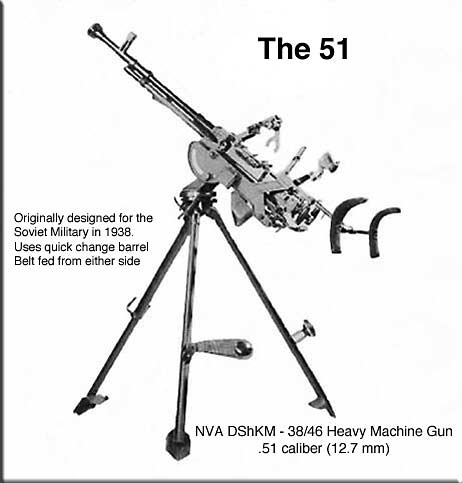
I know that on at least three different occasions that I destroyed .50 cal positions. Once, on a night flight in support of ground troops, we rolled in on the enemy which was engaging our grunts. As I touched off the first rocket, two 50s opened up on us. One of them was almost on line with my line of attack, and with a small adjustment, I put the ship right on this particular gun crew and dumped all my rockets right on top of him. At the same time, my wingman took on the other 50, nailing him with rockets, as well. There was no more fire from either of those positions, and I knew that my rockets had been on target. Another occasion was when we were again fired upon by a triangulated position, and one of the positions had the misfortune of being directly in front of me as I started my gun run. He, too, got several 2.75" rockets poured on top of him. This one was in the daytime, and not only did we not get any return fire, but we also got a secondary explosion, which indicated that the NVA also had other armaments in that position.
Another time, also during the height of Tet, we got scrambled to assist an ARVN company between Cu Chi and Saigon. It was reported to us that they were pinned down in a villa, and needed air support. When we got in the air, we made contact with the ARVNs US advisor via FM radio. As soon as we talked to him, we learned that he was wounded, laying in the courtyard of the villa, and that his ARVN troops had retreated to a safe area. They refused to make an attempt to retrieve the wounded American, wanting us to soften the enemy. We learned from the advisor that there was probably a platoon sized NVA element in a villa building about 30 yards from him, and as we made a low pass over the American's position, we received heavy AK fire, and a single .50 opened up on us, as well. We told the American to take whatever cover he could, and made a pass directly at the NVA building, breaking back over the wounded soldier. Again, we and our wingman took heavy fire, and my aircraft was rocked by a hit from the 50. But now we had the 50's position, and on my second pass I placed about 6 or 7 rockets right on top of him. The American, who could see what had happened from his very close position, told us that one of the rockets had been a direct hit on the 50 crew's position. The AK fire lessened, as well, and we called upon the ARVN to go after the advisor. They weren't about to budge. The American was trying to maintain radio contact with us, but it was plain that he was badly wounded, and our orders to the ARVN leader became more and more demanding that they go after him so that we could get him medevaced to Cu Chi, which was only a 5 minute flight away. No, they would not go after him. It was at this time that we seriously contemplated rolling in on the ARVN troops, since the cowardly little bastards were not about to save the poor American. Not wishing to be court-martialed, we decided that we would not kill our supposed allies, but it was Oh so tempting. Our crew was fuming, screaming every kind of obscenity at our Brothers in Arms, who were going to let that American soldier die because of their cowardice. We flew ever lower and slower over the wounded American, firing Minnie-gun and door guns at the NVA position until there was no return fire. Even then, the spineless bastards refused to retrieve what was now the body of an American serviceman, there in their country to save them from Communism. We left, helpless, without ammo, furious, and hoping that the NVA would kill every cowardly ARVN in that contingent. When I returned to our Operations, I gave an angry account of our allies' fighting ability, which I was assured would be forwarded to a higher authority. I don't know if anything happened to that ARVN unit, but I hope that they were all killed. They richly deserved it.
Tet rolled on. Day after day, the battles, rocket and mortar attacks, sleepless nights and constant contact became a blur. It is amazing that when under this type of combat stress, the body seems to be on auto pilot, and exhaustion from lack of sleep becomes almost normal to the point that we seemingly could still perform well for days on end. I am sure that our combat readiness suffered badly, but we were all so tired that nobody seemed to notice. The Offensive lasted a month, and during that time my unit alone was in on the deaths of many, many VC and NVA. Our losses were zero killed, but several wounded. In the war of attrition, there can be little doubt as to who the victor was. While we decisively won the battles during Tet, and put such a crimp in the enemy that the VC were virtually wiped out during the time, the press corps and the anti-war protestors gave the victory to the North. The political ramifications were harmful to the war effort, and the high officials did little to make it better. Tet became a political victory for the Communists, despite them getting their butts severely kicked militarily. Those of us who were doing the fighting and saw how both sides were faring never could understand how the NVA/VC got one in the Win column for this fight, but that is how the history books record the Tet Offensive.